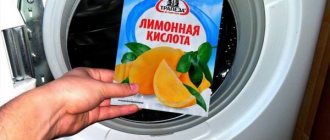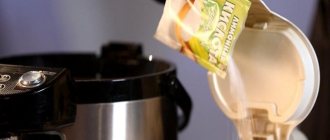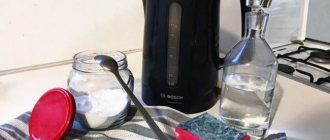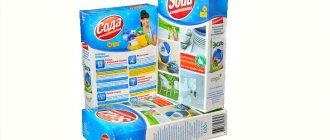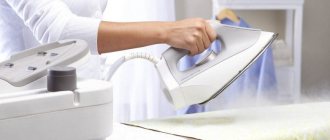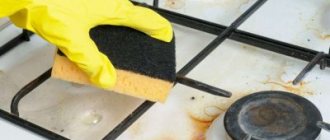Almost every person has encountered the problem of scale formation in an electric kettle and other electrical appliances, including a coffee machine. Over time, dense lime deposits begin to appear on the heating elements of the unit, which are difficult to remove with ordinary water. Cleaning the coffee machine with citric acid will allow you to get rid of scale as quickly and effectively as possible, without exposing the functional mechanisms of the unit to the harmful effects of aggressive chemicals and extend its service life without the need for repairs.
Why descale your coffee machine?
Pure water contains a large number of chemical elements such as calcium, magnesium, iron, potassium and chlorine, which when heated turn into lime, which settles on the heating elements of the machine. During the preparation of coffee, it flakes off and enters the drink in the form of white flakes, which make it unpresentable in appearance and tasteless. Scale also causes corrosion of various internal parts of the unit and leads to their premature failure. In addition, its porous structure promotes the proliferation of microorganisms and pathogenic bacteria.
Limescale, which accumulates inside the container and on the heating elements of the unit, forms a large layer of lime, which creates thermal resistance and worsens the thermal conductivity characteristics of the metal. This significantly increases the load on the electric heater and affects the length of time it takes to prepare the drink.
Most of the plaque is formed by calcium, so the procedure for cleaning a coffee machine is also called decalcification.
Signs indicating the need to clean the unit:
- the smell of coffee has changed (a musty feeling has appeared);
- the drink is not strong enough or is not fully brewed;
- steam pressure decreased significantly;
- During operation of the unit, uncharacteristic sounds are heard.
Some devices are equipped with special indicators for automatic control of scale. If a red light comes on on the device’s display or a corresponding message appears, it’s time to clean the coffee machine.
Is it permissible to clean a coffee machine with citric acid?
Today, many modern manufacturers offer a large number of different cleaning agents for coffee machines of different brands. But the best natural product for cleaning the unit is citric acid powder, which is sold in bags, as it has many benefits:
- it is safe for the human body;
- can effectively remove even old layers of scale;
- does not emit toxic substances during heating;
- environmentally friendly and does not harm the environment;
- cheaper than specialized products;
- can be purchased at any store.
Cleaning the coffee machine with citric acid
To effectively descale the unit, you must fully read the manufacturer's instructions and follow its recommendations. When preparing a solution of citric acid, you must strictly observe the specified proportions and strictly follow the developed algorithm for the procedure.
Amount of citric acid
Many people think that descaling a coffee machine will be most effective if descaling is carried out with a large amount of citric acid. But too high a concentration of powder can lead to damage to the internal elements of the unit. Therefore, the solution is prepared in compliance with the following proportions:
- for regular cleaning of the coffee machine, dilute 25-30 g of citric acid in 1 liter of water;
- To decalcify a heavily contaminated unit, make the solution more concentrated by adding water and 45-50 g of lemon powder.
You can buy citric acid at any grocery store or supermarket.
Dilution of citric acid
To prepare the cleaning solution, you need to heat the required volume of water to room temperature, pour the specified amount of citric acid into it and mix thoroughly.
The amount of water is taken in accordance with the manufacturer’s recommendations, which are indicated in the operating instructions for the coffee machine.
Cleaning process
Typically, decalcification of a coffee machine lasts about 30-40 minutes and consists of the following steps:
- descaling;
- first rinse mode;
- second rinse mode.
The procedure for decalcification:
- First, you need to de-energize the unit (remove the plug from the electrical outlet).
- Remove the reservoir and rinse it several times with a strong stream of running water.
- Pour the prepared solution into it and install it back into the unit.
- Connect the coffee machine to the mains and select the automatic cleaning option. If this option is not available, leave the solution in the container for 20 minutes and then press the coffee button.
- Repeat the process until the entire volume of the solution is used up by the device.
- Then turn off the power to the unit, remove the tank and rinse it well under running water.
- Carefully inspect the walls of the container: if scale remains on them, repeat the procedure.
- Fill the tank with purified water to the maximum allowable level and turn on the coffee brewing function (no need to add beans).
- Repeat the rinsing process of the unit one more time.
If everything is done correctly, the coffee machine will be completely descaled, and you will be able to drink coffee made from clean and tasty water.
Why is it better to choose lemon?
Positive aspects of the method
Citric acid is suitable for cleaning dishes and household appliances. It dissolves calcified formations in water.
Descaling a coffee machine with citric acid has its advantages. It does not contain aggressive toxins or flavors, so it does not cause allergic reactions. The exception is people with individual intolerance to the component.
Cleaning coffee machines from scale with citric acid helps remove all dirt. The substance also has a gentle effect on the mechanisms of the unit. Makes the equipment operate silently, which is considered a plus for a coffee machine.
Interesting! Electric Turks with automatic shut-off when boiling
Other benefits
A solution of citric acid increases the service life of the device and prevents its regular breakdowns.
Descaling a coffee machine with acid improves the aromatic and taste properties of coffee and makes the drink more concentrated.
The product does not pollute the environment. Suitable for coffee makers, Turks and other household appliances and utensils. This means it allows you to save on purchasing special cleaning powders for each item.
“Limonka” is a budget cleaning option. It costs 30-50 rubles in grocery stores, which is 3-10 times cheaper than professional detergents.
Negative points
Cleaning a coffee machine from scale with citric acid also has disadvantages.
Due to frequent cleaning, salt layers may form on the parts of the device. The product may corrode metal parts.
After treatment with lemon juice, a specific smell is formed that spoils the aroma of the first 2-4 cups of coffee. The taste of the drink also deteriorates.
Precautionary measures
Before cleaning the coffee machine, you must read the manufacturer's instructions, which indicate the frequency of the decalcification process. When cleaning the unit, all safety precautions should be observed:
- Before carrying out the procedure, you must disconnect the device from the power supply;
- For cleaning, use only products approved by the manufacturer;
- do not use concentrated solutions that may adversely affect the operation of internal elements;
- Avoid getting water on the internal parts of the coffee machine so that a short circuit does not occur after turning it on.
Cleaning instructions
Three stages
To understand how to properly clean a coffee machine from dirt, read the step-by-step algorithm:
- Remove scale and blockages.
- After cleaning, rinse the coffee machine for the first time.
- Rinse a second time.
Example on a Philips coffee machine
Cleaning a Philips coffee machine is as follows.
Disconnect the device from the power supply. Remove the water container from the device and rinse it under cold water.
Prepare an acid solution. Add “lemon” to the water in the ratio: 25 grams of product per liter of liquid. Dilute the solution until you get a homogeneous consistency.
Pour the resulting solution into the water compartment and attach it to the device. Leave for 20 minutes for the product to react with the dirt.
Interesting! What to brew coffee in: review of utensils
Plug in the machine and activate the preparation of a drink without coffee raw materials. This will help clean up all the technical parts. To be on the safe side, run the process again.
Final actions
Disconnect the device from the power supply, remove the liquid compartment, and rinse it under cold water. If stains from the cleaning solution remain on the container, remove them again. If the compartment is clean, start rinsing the parts.
Fill the liquid reservoir with cold running water, connect it to the machine, and activate the coffee brewing function. Repeat the procedure 2 times.
After rinsing, remove the compartment and inspect it for acid stains. If the product is not washed well, you need to rinse the tank 3 times.
Pollution prevention
In order to reduce the amount of scale and reduce the number of procedures to remove it, experts recommend using only bottled or purified water with a low degree of hardness.
In addition, adjustments should be made to the water hardness setting system, since otherwise the device will signal too often (or very rarely) that the decalcification process is necessary.
Also, the use of purified water will be an effective prevention for units that are equipped with a built-in filtration system, since it is sometimes not enough to protect the important components of the coffee machine from the appearance of lime deposits.
Regardless of the configuration, technical characteristics and functionality of the coffee machine, it is recommended to decalcify it with citric acid or other special means at least once a year. This will not only help get rid of scale, but will also significantly extend the life of the household appliance.
Requirements and rules
Basic
Cleaning with lemon juice is considered a safe chemical method. The main thing is to follow the proportions and rules of use. And then you will be able to avoid malfunctions in the operation of the coffee machine.
To properly descale your coffee machine with citric acid, please refer to the instructions for use. It will help you understand whether home methods can be used. Your coffee machine may have a special sensor and a self-cleaning system.
If your coffee maker has removable brewing units, wash them every 2 days. To do this, use running water. This will help prevent future breakdowns.
Before washing, make sure that there is no water or coffee beans in the coffee maker. This is especially true for carob-type devices and those with a coffee grinder. This way you can prevent unpleasant noise and malfunctions during the operation of the device.
Additional
When washing, pay attention to the sieve and holder. It is better to clean them under running water without special products or soap solutions, so that the drinks do not have an unpleasant odor or taste.
After cleaning the coffee machine, rinse its parts with plain water. This will remove acid residues and prevent salt stains and damage.
Interesting! How to properly descale a coffee maker at home
Follow the recommendations and quickly remove scale from the mechanisms of household appliances. The tips will also help if you don’t know how to descale your coffee maker.
Information on the topic is contained in the article “How to properly descale a coffee maker at home.”

